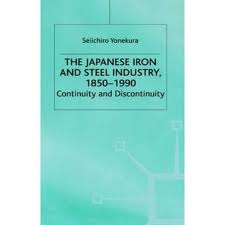 The Japanese Iron and Steel Industry 1850-1990
by YONEKURA Seiichiro
The Japanese Iron and Steel Industry 1850-1990
by YONEKURA Seiichiro
 The Japanese Iron and Steel Industry 1850-1990
by YONEKURA Seiichiro
The Japanese Iron and Steel Industry 1850-1990
by YONEKURA Seiichiro
Yonekura wants to diminish the role of MITI, however government cooperation and support of JP's steel industry (no trust-busting in Japan like existed in the US) seemed to play a bigger role than he admits.
From 1850 to 1990, the industry increased crude steel production from virtually nothing to 109 million tons (the second largest in the world). When we consider that Japan has to import 99 percent of its iron ore from abroad ...
The Basic Oxygen Furnace was invented in Austria in 1952 as a steel refining furnace that could take the place of the Open Hearth Furnace...
It reduced refining time to a tenth of what it had been, thereby increasing the efficiency of the furnace, and it saved half the construction cost. The rate at which Japan introduced the BOF was much faster than the rate at which the United States, the nine countries of the European Economic Community (EEC), or Canada introduced it.
In 1789, when he decided to leave England for America, Samuel Slater was a foreman at Jedediah Strutt's cotton mill...
In those days, however, it was very difficult for a skilled mechanic to leave England, because the British government prohibited the exportation of any machinery, or diagrams and even the emigration of any trained personnel...
Slater evaded these restrictions by disguising himself as a farm boy
The unsuccessful results of the Kamaishi Works (late 1800s) in its early stages were not a total loss, since its trial and error experience and accumulated expertise facilitated a further technology transfer.
While Hanyang Iron Works (chinese), which suffered from corruption, nepotism, foreign intervention, and political struggles, could not establish a solid management, the Yawata Works never experienced such corruption and political struggles. Japanese bureaucrats, who had to pass a standardized and difficult national examination, were usually well respected and independent of politics, both central and local.
As we examine the four companies, Sumitomo Copper, Kobe Steel, Kawasaki Hyogo, and Nihon Seiko-sho, we see that all had strong ties with the Navy and NRB (National Railways Bureau), developing to supply their special needs.
Although the industry developed rapidly during the First World War, the sharp economic downturn immediately after the war hit the over-extended industry so hard that it necessitated major readjustment. In the resultant shadkedown, the imbalance betweeen iron and steel development grew worse and large reorganization occurred. Firms fell under the wings of various zaibatsu.
The government (the Yawata Works and the relevant ministries), industry (not only iron and steel but other industries such as shipbuilding, machinery, railway, distribution, and so on), and academia were all represented (in the Iron and Steel Institute of Japan). Because of this interdisciplinary orientation, ISIJ wa, and still is, able to disseminate the lates knowledge and technology on iron and steel throughout the relevant industries and to facilitate speedy industrial development. ISIJ developed three important devices for technology diffusion and information sharing. These were: 1), its monthly magazine, Tetsu to Hagane (Iron and Steel), 2) periodical lectures and its annual conference, and 3) the Cooperative Research Divisions.
The structure of the alloy (cobalt steel) was basically created in my brain. It was not created merely by chance or by accident. Japanese researchers would do well to learn from my example.
The bank crisis of 1927 was the largest in Japan's history ( lol ). Although the crisis was directly caused by the huge moratorium bills for reconstruction issued after the Kanto earthquake in 1923, in reality it took place against the relatively weak showing of the Japanese economy after the first World War.
Although Prime Minister Inukai reluctantly accepted the conquest of Manchuria by the Army, he opposed any further Army expansion into China. He was enraged by the Army's usurpation of party rule and tried to control the Army's aggression into China. Because of his moderate attitude, however, he was assassinated by ultra-nationalistic military officers on 15 May 1932.
(1943) In order to realise the national goal, that is to achieve the war economy and promote the private interest simultaneously, the government had to maintain the profit orientation of the private firms within the framework of the national goal, on the other hand,, while private firms had to reconcile their profit orientation with the national goal in order to maintain their autonomy
With the outbreak of the Cold War, particularly after the Greek Rebellion of 1947, the government of the United States began to change its occupation policy from one that emphasized punishment (for zaibatsu) to one that aimed at supporting Japanese economic recovery. The United States decided to aid in Japan's economic development to prevent the spread of communism in the Far East.
With the final termination of subsidies on 1 July 1950, the industry fell into chaos.
It was nothing more than superb luck, then that the Korean War broke out at nearly exactly the same time: 25 June 1950. Procurement by the US military and a sudden price rise radically changed the deflationary environment
The second question that comes to mind is how the industry could fund such great expansions. In the investments of the Second and Third Programmes, the external procurement of capital (short-term loans and company bonds) consisted of around 40 to 50 per cent of total investment...
It should also be noted that the World Bank played an important role in funding the Japanese iron and steel rationalisation programmes, loaning 84 million dollars to Kawasaki, Sumitomo, and Kobe (1955-1960)...
Besides merely funding their expansion plans, the loans from the (World) bank also strengthened the over-borrowing pattern of the Japanese firms.